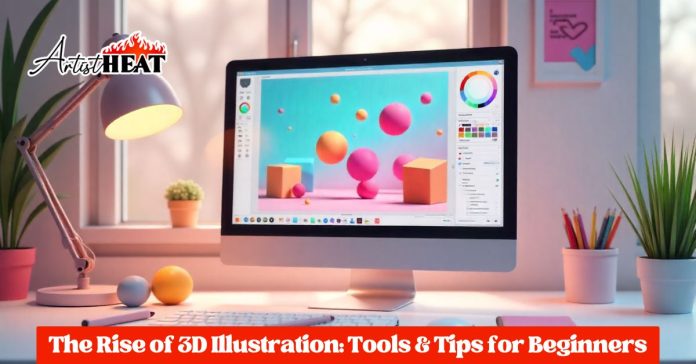Do you recall how you needed those silliest red and blue glasses to watch a 3D movie and resembled a cheap superhero? Well, things have changed and so is the world of digital art. The rise of 3D illustration has transformed from a niche skill reserved for movie studios into an accessible art form that’s literally everywhere you look – from Instagram posts to website headers, product mockups to NFT collections.
And the fact that it appears to be everywhere and nearly everybody can do it, when you were scrolling through social media recently and asking yourself when digital Michelangelos ran rampant, you are not alone (we are as well).
Why 3D Illustration is Having Its Main Character Moment
Admit it, it’s a visual world, we’re living in the world where standing out is more difficult than finding a parking spot at the mall on black Friday. Classic flat design – even though it’s lovely – can be as thrilling as plain yogurt when all you wanna eat is ice cream. The rise of 3D illustration isn’t just a trend; it is a reaction to our pent-up desire of in-depth, texture and OMG how did they do that? factor.
The pandemic contributed a massive part to such a transition. As all people were sitting at home and looking at the screens, brands understood that they had to do more to attract attention. Enter 3D illustration – sprinkles on top of everything artistic. All of a sudden, websites were no longer functional, but experiences. Products were not merely photographed, but remade in implausible colour and even defying gravity situations.
The Tools That Are Changing Everything
Blender: The Free Powerhouse
Let’s start with the elephant in the room – Blender. This free, open-source software has done for 3D illustration what TikTok did for 15-second fame: it democratized the industry on a whole. Prior to the point when Blender became usable (and I mean this term low-hanging fruits), the only two ways to learn about 3D were by either completely getting rid of a kidney to afford Cinema 4D or staring in the face the possibility of never being able to 3D other than all your fantasies will remain 2D.
So, in 2025 the Blender interface will be so user-friendly that even my technologically-impaired neighbor would, perhaps, be able to build a spinning donut (which, by coincidence, is an initial masterpiece of all Blender beginners). The software is enhanced with Ai-guided modailing tools which have the capability to produce simple shapes through text description, thus the learning curve is not too high like that of mount everest.
Cinema 4D: The Professional’s Choice
Blender is the rough around the edges underdog, Cinema 4D is the neat, well-prepared professional, and he or she arrives with five minutes to spare with neatly tabbed notes. Yes, it is expensive; more than I even spend on coffee per month, but it is the tool of excellence, especially when dealing with commercial stuff, sort of the Swiss army knife, which also makes awesome cappuccinos.
The 2025 updates also comprise real-time ray-tracing, which makes your renders so real, you might not be sure what is real anymore. Such artists such as Peter Tarka have been pushing the envelope when it comes to C4D, creating 3D illustrations that look like they were pulled from fever dreams of a design-obsessed AI.
Dimension and the Adobe Ecosystem
Adobe Dimension deserves a special mention for being the gateway drug of 3D illustration. It is training wheels in 3D, which fits for those people who are used to working with Photoshop and Illustrator. It is not going to earn any award as to the complexity, but it is what you need to create any product mockup as well as a simple scene without having to learn a completely new interface.
Getting Started Without Losing Your Sanity
Master the Basics First
Here’s some tough love: you can’t run before you walk, and you can’t create mind-bending 3D illustrations before you understand basic shapes. Begin with easy figures beginning with spheres, cubes, cylinders. It may not be an exciting thing to hear but in fact, light dealing with fundamental forms is as well essential to comprehend.
Consider it as it would be like learning to cook. You can not learn beef wellington first; you learn scrambled eggs. Designers such as Six N. Five are not artists that woke up one morning and drew those surreal, imaginary sceneries. They invested time in getting basics and this reflects in their work.
Lighting is Your Best Friend (And Worst Enemy)
If modeling is the foundation of 3D illustration, lighting is the makeup artist that makes everything look good. Worst kind of lighting makes it seem the most detailed model is on a potato. By using good lighting you can make a plain sphere appear to have come out of a museum.
It is important to learn to analyze real-life lighting when and where it occurs obsessively. What is the way sunlight streams into your window? What pattern do shadows make of your desk? The finest 3D artists are in effect professional light stalkers, continuously checking how light can influence a mood and an atmosphere.
Don’t Skip the Composition Lessons
Just because you can create a perfect 3D banana doesn’t mean you should put seventeen of them in your scene. Composition rules from traditional art still apply in 3D illustration. Rule of thirds, leading lines, negative space – those are not pieces of long forgotten photographic knowledge; they are your power things.
Take a look at the work of such artists as Ash Thorp or Maciej Kuciara. Their 3D illustrations work because they understand that technical skill without compositional knowledge is like having a Ferrari with no engine – it looks impressive, but it’s not going anywhere.
The Future is Bright (And Probably AI-Assisted)
Real-Time Everything
The future of 3D illustration is moving toward real-time rendering faster than fashion trends cycle through TikTok. Whereas in the past the technology would require hours in order to render, with the new enhancements in GPU and smarter algorithm, it all occurs within fractions of a second. That implies experimentation, accelerated iteration, and, in the end, improved art.
The Unreal Engine 5, a longtime industry tool to make games, is finding many applications in 3D graphic illustration and motion graphics as well. It has a Lumen lighting system and Nanite virtualized geometry, which are game-changers to allow photorealistic rendering to be within the reach of artists who do not have access to server farms in their basements.
AI Integration That Actually Helps
Unlike the AI panic that’s sweeping other creative industries, AI in 3D illustration is actually pretty exciting. Such products as NVIDIA Omniverse or Adobe Substance are implementing AI functionality aimed at automating duller tasks, so that artists could spend time getting creative, not running busywork.
How about when you explain something in plain English about a texture, and the AI renders that texture, or you draw a rough concept and the AI proposed 3D models that fit your idea. This is not replacing artists; this is bestowing artist with superpowers.
Common Mistakes That Make Me Cringe
The Perfectionism Trap
Here’s a reality check: your first hundred 3D illustrations will probably look like they were created by someone wearing oven mitts. It is natural. The greatest error that beginners do is they use three weeks to perfect a single project rather than making thirty projects that are not perfect.
Ignoring Reference Material
Far be it you to belittle your imagination, but the laws of physics leave the 3D space intact. Even unreal situations find basis on reality, in case of the most believable 3D illustrations. Gather the references maniacally: pillow materials and fabrics, lighting or color schemes, composition designs.
The Bottom Line
The rise of 3D illustration represents more than just a shift in aesthetic preferences; it’s a fundamental change in how we communicate visually. The tools are increasingly becoming more accessible, the learning materials all-embracing, and the opportunities are multiplying more as we creep further into 2025 and beyond.
Be it a designer trying to enrich his or her proficiency or the layman seeking to determine whether he or she can acquire a knack of the 3D illustration without hanging a degree in computer science, it is possible. It is hard, sometimes frustrating, still worth it in the end in a way that is beyond the flat design.
The main point is to begin today, begin easy and do not forget that all the professionals were once the beginners who have been unacceptable to quit. The rise of 3D illustration isn’t just happening around us – we can all be part of it.

